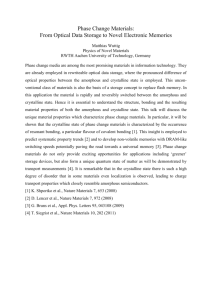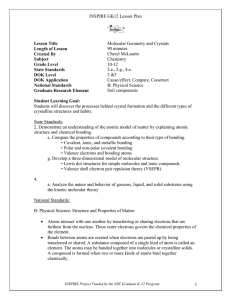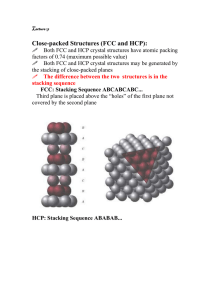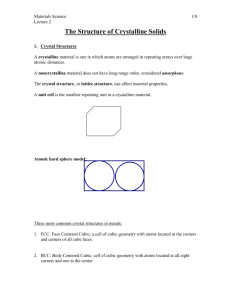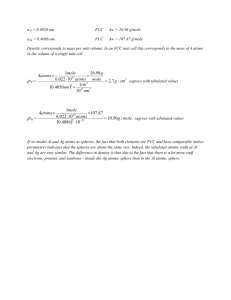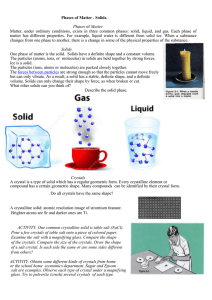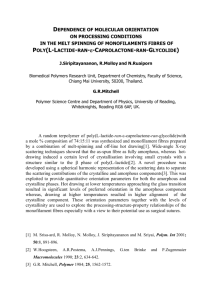Crystal Structures 3.2 Fundamental Concepts
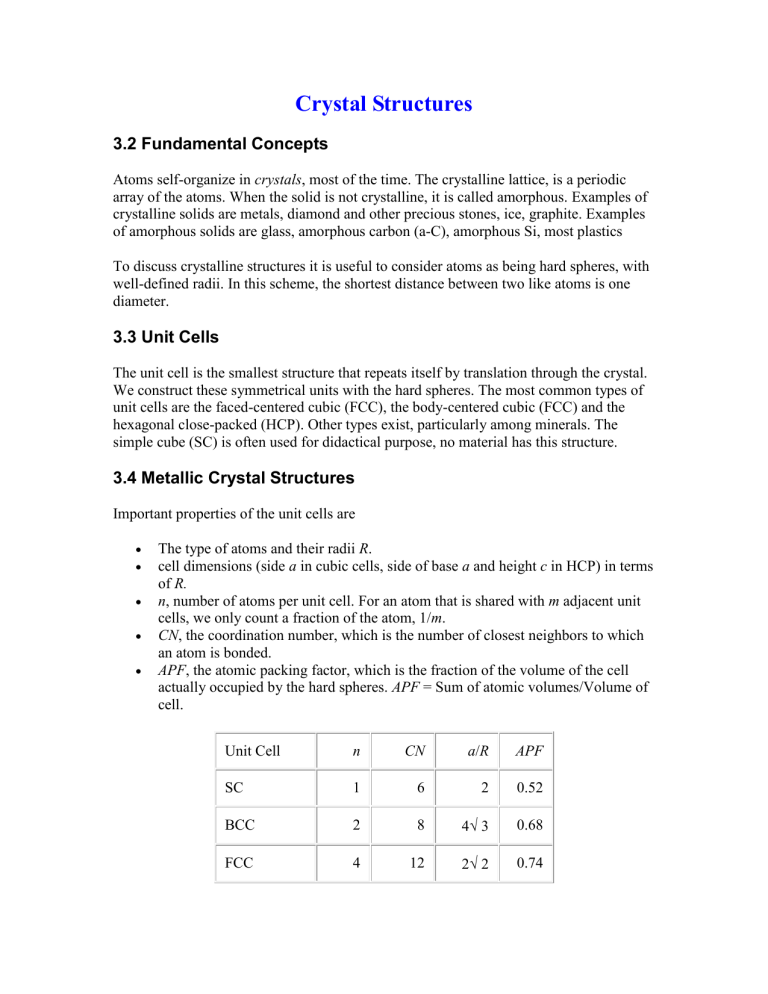
Crystal Structures
3.2 Fundamental Concepts
Atoms self-organize in crystals , most of the time. The crystalline lattice, is a periodic array of the atoms. When the solid is not crystalline, it is called amorphous. Examples of crystalline solids are metals, diamond and other precious stones, ice, graphite. Examples of amorphous solids are glass, amorphous carbon (a-C), amorphous Si, most plastics
To discuss crystalline structures it is useful to consider atoms as being hard spheres, with well-defined radii. In this scheme, the shortest distance between two like atoms is one diameter.
3.3 Unit Cells
The unit cell is the smallest structure that repeats itself by translation through the crystal.
We construct these symmetrical units with the hard spheres. The most common types of unit cells are the faced-centered cubic (FCC), the body-centered cubic (FCC) and the hexagonal close-packed (HCP). Other types exist, particularly among minerals. The simple cube (SC) is often used for didactical purpose, no material has this structure.
3.4 Metallic Crystal Structures
Important properties of the unit cells are
The type of atoms and their radii R .
cell dimensions (side a in cubic cells, side of base a and height c in HCP) in terms of R.
n , number of atoms per unit cell. For an atom that is shared with m adjacent unit
cells, we only count a fraction of the atom, 1/ m .
CN , the coordination number, which is the number of closest neighbors to which an atom is bonded.
APF , the atomic packing factor, which is the fraction of the volume of the cell actually occupied by the hard spheres. APF = Sum of atomic volumes/Volume of cell.
Unit Cell
SC
BCC
FCC n
1
2
4
CN
6
8
12 a / R APF
2 0.52
4
3 0.68
2
2 0.74
HCP 6 12 0.74
The closest packed direction in a BCC cell is along the diagonal of the cube; in a FCC cell is along the diagonal of a face of the cube.
3.5 Density Computations
The density of a solid is that of the unit cell, obtained by dividing the mass of the atoms
( n atoms x M atom
) and dividing by V c
the volume of the cell ( a 3 in the case of a cube). If the mass of the atom is given in amu ( A ), then we have to divide it by the Avogadro number to get M atom
. Thus, the formula for the density is:
3.6 Polymorphism and Allotropy
Some materials may exist in more than one crystal structure, this is called polymorphism.
If the material is an elemental solid, it is called allotropy. An example of allotropy is carbon, which can exist as diamond, graphite, and amorphous carbon.
3.7 – 3.10 Crystallography – Not Covered
3.11 Close-Packed Crystal Structures
The FCC and HCP are related, and have the same APF . They are built by packing spheres on top of each other, in the hollow sites (Fig. 3.12 of book). The packing is alternate between two types of sites, ABABAB.. in the HCP structure, and alternates between three types of positions, ABCABC… in the FCC crystals.
Crystalline and Non-Crystalline Materials
3.12 Single Crystals
Crystals can be single crystals where the whole solid is one crystal. Then it has a regular geometric structure with flat faces.
3.13 Polycrystalline Materials
A solid can be composed of many crystalline grains, not aligned with each other. It is called polycrystalline . The grains can be more or less aligned with respect to each other.
Where they meet is called a grain boundary .
3.14 Anisotropy
Different directions in the crystal have a different packing. For instance, atoms along the edge FCC crystals are more separated than along the face diagonal. This causes anisotropy in the properties of crystals; for instance, the deformation depends on the direction in which a stress is applied.
3.15 X-Ray Diffraction Determination of Crystalline Structure
– not covered
3.16 Non-Crystalline Solids
In amorphous solids, there is no long-range order. But amorphous does not mean random, since the distance between atoms cannot be smaller than the size of the hard spheres.
Also, in many cases there is some form of short-range order. For instance, the tetragonal order of crystalline SiO
2
(quartz) is still apparent in amorphous SiO
2
(silica glass.)
